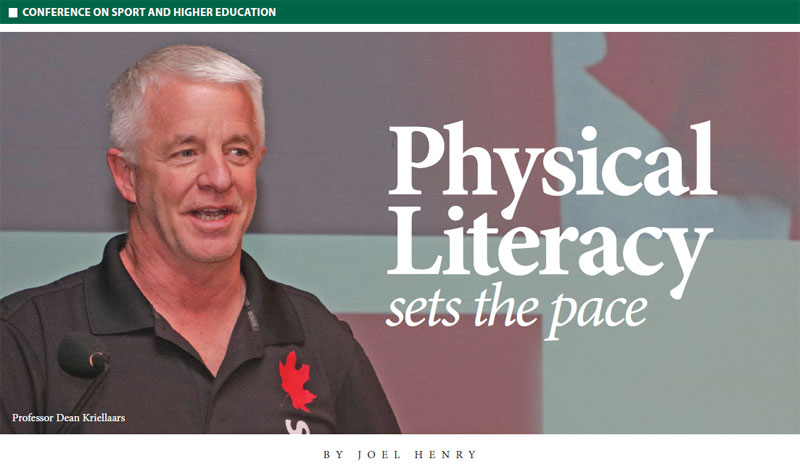
In childhood we are movers by nature. Children dance without the need for music. They climb anything they can find. An open space is an invitation to run. Their imaginations power them forward – superheroes, martial arts experts, warrior princesses saving the day in the front yard. As they get older, most of them will move less and less. As societies become more complex and less safe, this phenomenon becomes even more pronounced.
There is a growing body of knowledge that shows we have underestimated how detrimental this lack of movement is to children’s physical and mental health. So says Dr Dean:
“You want every boy and girl to be able to throw, jump, run, hop, skip and swim. If they can do that we have found it generates confidence and if they have confidence that generates motivation. If you are motivated that generates more participation.”
“If you participate in life in a meaningful way you thrive. You also have better mental and physical fitness. Physical literacy is cognitive and physical at the same time,” he says.
The International Physical Literacy Association defines physical literacy as, “the motivation, confidence, physical competence, knowledge and understanding to value and take responsibility for engagement in physical activities for life.”
Professor Dean Kriellaars, or Dr Dean as he has become known through his international work, knows quite a bit about physical literacy. He is renowned as one of the architects of the Physical Literacy Movement. For more than 15 years he has combined his knowledge in neuroscience and physical therapy with advocacy about the importance of movement. He works with several organizations such as the International Sports for Life Society, the Aspen Institute and even Cirque du Soleil.
“In essence, I’m a physical literacy evangelist,” he says during our interview at the University Inn just off campus in St Augustine.
Even while sitting, Dr. Dean is in constant motion. He leaps to catch every question, absorbs it quickly and races away with his answers. Compact and middle-aged, it’s obvious he is a practitioner of physical literacy as well as a preacher.
Dr Dean, an associate professor in the Department of Physical Therapy at the University of Manitoba in Canada, was in Trinidad for the Second Biennial Conference on Sport and Higher Education held from May 18 to 20 to give the keynote address. Trinidad and Tobago is only one stop on a sprint that carries him across the world.
“Last week I was in Calgary, Toronto; then Washington DC, Miami and Trinidad. After this I am going back to Winnipeg, then New Finland, Quebec City and Montreal before June 3,” he says.
At his stop in Washington DC his presentation on physical literacy was followed by a speech from Michelle Obama, First Lady of the United States of America, at the 2016 Project Play Summit. Project Play was a gathering of over 450 specialists that focused on children and sports.
On his first of what he believes may become many visits to Trinidad, Dr. Dean says he was very impressed by the awareness of physical literacy issues at the Sport and Higher Education Conference hosted by the St. Augustine Campus at the Learning Resource Centre.
“It way exceeded my expectations,” he said. “The conference showed me that people know where they want to go. They understand the problem and are passionate about it. I'm very excited for the future and the interrelationships in terms of what we can do.”
His keynote presentation, energetic and informative, was a highlight of the event. Dr. Dean told a story of societies – almost all societies – losing the ability to move. The results of that loss he measured in rising rates in type 2 diabetes (afflicting an estimated 30% of the population in the US and Canada). Children, he told the audience consisting of representatives from the health, education and physical education sectors, should “huff and puff” at least 60 minutes a day. Adults should do the same for at least 20 minutes a day.
“Learning to move is just as important as learning to read and write,” he said.
Dr. Dean also stressed the importance of encouraging girls to continue to take part in physical activity:
“Kids, particularly girls become inhibited by failure and withdraw. They stop participating. At five, six and seven, boys and girls play together. By 12 years old that stops. That's not because girls aren’t capable. Parents are six times more likely to caution a girl than a boy on the playground. If you are not equipping girls at the same level as boys, that is a crime. But yet every culture does it.”
But Dr. Dean was enthusiastic about the possibility of change. For much of history, we had no choice but to move. The average occupation was outdoors, not inside an office seated at a desk. Today movement is a choice and the physical literacy evangelist believes that people can be convinced it is the right choice.
“It’s about spreading the word,” he says. “The game is finding a community, possibly a country that starts the domino effect. In Canada, the example was recycling. It spread. It’s really about showing good examples.”
|





